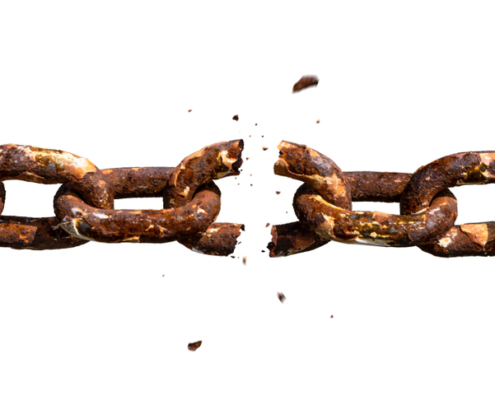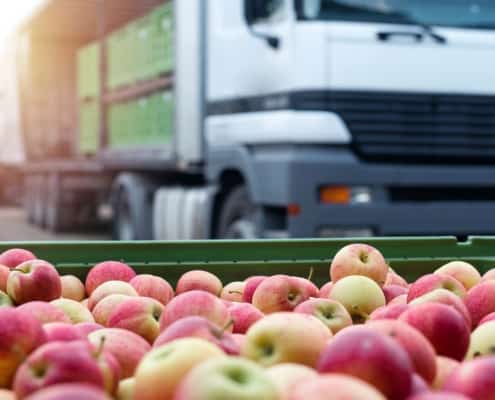Key Factors Influencing Cold Chain Success
Successful cold chain management involves much more than simply maintaining the product at the proper temperature. There are many factors that you must consider and address in order to ensure the integrity of your cold chain.
Regulation
Compliance with industry-specific, national and international standards and regulations, such as Good Distribution Practices (GDP) for pharmaceuticals, Hazard Analysis and Critical Control Points (HACCP) for food, and others, is critical for maintaining product safety and efficacy, minimizing legal risk and competing in global trade. Shippers must maintain proper documentation that demonstrates compliance with applicable regulations, including temperature logs and transportation records.
Sustainability
Sustainability concerns are an increasingly important factor in cold chain management. The food and beverage cold chain alone is responsible for 4% of global greenhouse gas (GHG) emissions. Creating a more sustainable cold chain requires a comprehensive approach combining more efficient transportation, improved energy efficiency in refrigeration units, reduced refrigerant leakage, and minimizing food waste due to spoilage.
Food Waste
One of the key objectives of cold chain management is avoiding food waste resulting from spoilage due to improper temperatures. Minimizing food waste translates directly to the bottom line for food producers: the more product that reaches the marketplace in saleable condition, the greater opportunity food producers have to turn a profit.
Product Efficacy
The efficacy and safety of pharmaceutical products such as medications and vaccines are greatly influenced by proper temperature controls. Failure to maintain these products at the proper temperature can lead to degradation of the product, reducing their effectiveness and even causing potential health risks.
Differences Between Cold Chain and Traditional Supply Chain
While the cold chain and the traditional (i.e., non-temperature controlled) supply chain both focus on the efficient and cost-effective movement of goods from their origin to the end consumer, in addition to the temperature controlled aspects, there are significant differences in the types of products they handle, the relevant regulations and requirements, and the equipment and infrastructure required to successfully maintain products throughout the cold chain.
Product Types
The traditional supply chain handles products that are non-perishable, a vast category including dry goods, electronics, apparel, many (but not all) electronics, machinery, etc. Perishable food goods such as fresh foods (dairy, meat, seafood, fruits, and vegetables), pharmaceuticals (vaccines and medications), certain chemicals, and some agricultural goods require cold chain shipping to maintain freshness and integrity.
Regulation
In the traditional supply chain space, regulations are primarily focused on transportation safety, labeling and other guidelines. In the cold chain industry, shippers must adhere to more stringent safe handling requirements to ensure compliance and product safety.
Equipment and Infrastructure
Shipping in the traditional supply chain often requires little more than a truck to haul the goods and a warehouse to store them. The cold chain, however, requires specialized equipment and infrastructure the entire supply chain, including refrigerated trucks, reefer containers, temperature-controlled warehouses, freezers, blast chillers, and cold rooms.
Main Components of the Cold Chain
Let’s take a closer look at the key components of the cold chain.
Cold Chain Shipping
Think about what would happen if you took an ice cube out of your freezer and simply walked outside with it in your hand. Even if it’s not a particularly hot day, the ice cube will almost instantly begin to melt. Now think about how a manufacturer can ship thousands of gallons of ice cream across the country while maintaining the proper consistency of the product all the way to your local grocery store. Cold chain shipping is a modern miracle that combines many kinds of specialized modes of transportation, including refrigerated shipping containers and refrigerated trucks (also referred to as “reefers”), temp-controlled air cargo and cold storage facilities including warehouses and distribution centers.
Cold Chain Packing
In the cold chain, temperature fluctuations are the enemy. Packaging acts as an additional line of defense, protecting products from spoilage. Common cold chain packaging techniques include insulated boxes, gel packs and dry ice, thermal blankets and liners, and phase change materials (PCMs), substances within packaging that absorb or release heat to maintain products at the desired temperature.
Temperature Monitoring in Cold Chain
Today’s cold chain shippers have a variety of real-time temperature-monitoring technologies at their disposal, including data loggers that record temperature and humidity levels inside shipments, IoT-enabled sensors that transmit live temperature data during transit, integrated telematics systems that combine temperature monitoring with GPS location tracking, and temperature monitoring software platforms that aggregate sensor data, providing comprehensive cold chain visibility.
Cold Chain Use Cases in Different Industries
While the broad objective of cold chain logistics management is similar in both the food and pharmaceutical industries, there are important differences that make implementing cold chain solutions in these respective industries unique.
Cold Chain in the Food Industry
- Main purpose and focus: Preserving freshness, taste, texture, nutritional value, and safety and preventing spoilage and food waste.
- Regulatory requirements: Food safety standards such as HACCP (Hazard Analysis and Critical Control Points), FSMA (Food Safety Modernization Act), and various national food safety agencies (e.g., FDA, USDA) regulate the food cold chain to prevent contamination and ensure food safety.
- Temperature Control: Temperature control varies depending on the food product. Refrigerated Freight maintains products at above freezing temperatures, typically between 34°F-50°F (1°C-10°C) and is commonly used to transport fresh produce, dairy products, and beverages that need to be kept cool but would be damaged by freezing. Frozen Shipping maintains products such as ice cream, frozen vegetables, meats, seafoods, prepared frozen foods, and some specialty ingredients at temperatures below freezing, typically between 0°F to -22°F (-18°C to -30°C).
- Packaging: As noted above, common packaging for food and beverage products typically includes insulated boxes, gel packs and dry ice, thermal blankets and liners to protect against spoilage as well as physical damage.
Cold Chain in Pharmaceuticals
- Main purpose and focus: Maintaining the stability, efficacy, and safety of temperature-sensitive goods such as drugs, vaccines, biologics (drugs derived from the cells of animals, plants or microorganisms) and other medical products and ensuring these products are safe and adhere to regulatory requirements.
- Regulatory requirements: Regulatory frameworks such as Good Distribution Practice (GDP), Good Manufacturing Practice (GMP), and stringent guidelines from regulatory bodies such as the FDA, EMA (European Medicines Agency), and WHO (World Health Organization) govern the pharma cold chain to ensure product efficacy, potency, purity, and safety.
- Temperature Control: Many healthcare products are shipped at refrigerated and frozen temperature ranges. In addition, some pharma products, biological samples and genetic materials for research are shipped at cryogenic temperatures, typically below -238°F (-150°C).
- Packaging: In addition to insulated boxes, gel packs and dry ice, thermal blankets and liners, pharma products are also commonly protected from light, humidity, shock, and tampering through the use of vacuum-insulated panels and smart packaging with embedded sensors.
Challenges in Cold Chain Logistics
Common challenges in the cold chain logistics industry include:
Cold Chain Monitoring
Monitoring the cold chain in real-time requires a comprehensive suite of technologies, including GPS and IoT-enabled tracking devices, RFID (Radio Frequency Identification) and NFC (Near Field Communication) Tags, and cloud-based monitoring platforms.
Leveraging Data for Better Decision-Making
Utilizing these technologies empowers cold chain managers with the data they need to make more informed, timely decisions and make a positive impact on overall supply chain management:
-
- Improved product safety and quality
- Enhanced compliance
- Reduced product losses and waste
- Enhanced operational efficiency
Cold Chain Management Requires the Right Partners
Cold chain management is a complex process; selecting the right partners is critical to ensuring your products are maintained at the peak of freshness and quality. Here are some key considerations to keep in mind when selecting the right partners to support your cold chain needs:
- Define your specific cold chain goals, objectives and requirements
- Evaluate potential partners’ expertise and experience
- Assess cold chain technology and infrastructure capabilities
- Verify regulatory compliance practices and certifications
- Assess risk management practices
- Review cost structures
- Assess scalability
- Conduct site audits
- Consider trial runs
- Evaluate communication and support resources
- Assess sustainability practices
- Define service level agreements (SLAs) driven by KPIs
If your company produces temperature-sensitive products, your overall success depends on understanding the unique requirements of your products, investing in advanced monitoring technologies, and partnering with the right logistics solutions and service providers who have the expertise, infrastructure, and commitment to compliance and sustainability. By prioritizing these elements, you can minimize risk, reduce waste, streamline operations, and ultimately protect both your brand and consumer health. To learn more about optimizing your logistics operations, please contact Sheer Logistics.









